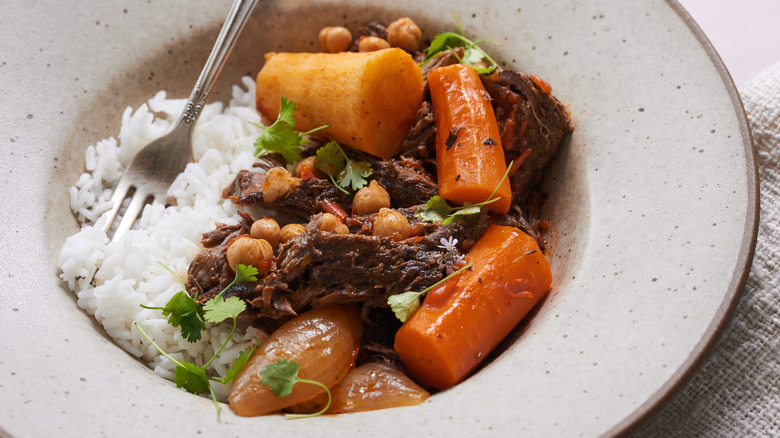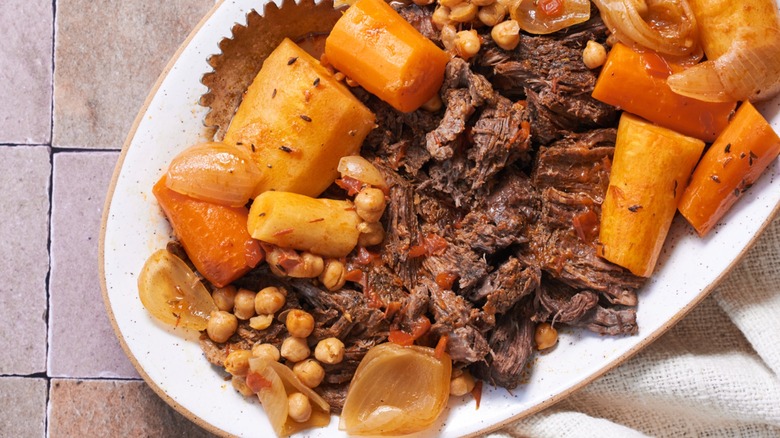Harissa Beef Pot Roast Recipe
Pot roast is one of America's most beloved comfort foods, originating in New England from French and German immigrants and quickly becoming a classic for cold Yankee winters. Often associated with the Midwest because of its casserole-like preparation, pot roasts are typically large, tough cuts of beef slow-cooked with carrots, potatoes, and onions. And even though it's quintessential for northern winters, pot roast has even made its way south, becoming a spicy, juicy version of the same braised beef. The peppers in Mississippi pot roast turn something dense and heavy into something suitable for any weather, even southern summers.
In this recipe written by Michelle McGlinn, peppery harissa is used in the same way to make a spicy, bright pot roast perfect for summer and winter alike. It's beefy and comforting but also hot and lemony, with nutty-sweet parsnips to balance the richness of the meat. It's the pot roast you know and love but with a Moroccan flair — it's easy to put together for dinner in a blizzard, but also perfect for a sultry summer soiree.
Gather the ingredients for a harissa beef pot roast
To start, you'll need a large cut of beef. We used a chuck shoulder roast, an inexpensive cut with more fat than brisket or round. It's the most flavorful, the easiest cut to work with, and the most shreddable once cooked. For clean slices, try a beef brisket, and for a less beefy flavor, try a beef round roast. With all three, the meat will require time to tenderize and that may need to be adjusted per cut and size. For something a little more luxe, you can also swap in beef short ribs.
For the rest of the pot roast, you'll need salt and pepper, whole cumin, lemon, olive oil, onion, garlic, harissa, chicken or vegetable stock, chickpeas, carrots, and parsnips. The harissa in this recipe is a sauce or paste made of red peppers and spices and can be found in most grocery stores in the International aisle or near the jarred peppers.
Toast and sear the cumin and lemon
First, preheat the oven to 300 F. Then, to open up the fragrance and flavor of whole cumin, toast it gently over the stove in a dry skillet before adding it to the dish. It's easiest to use a small skillet here so you can slide the spices into a bowl once they are browned, but you could also toast them directly in the Dutch oven. This will only take about a minute, so don't walk away from the stove or the cumin will burn.
In the Dutch oven, heat a layer of oil over medium heat and sear the lemons. The darker the better (avoiding burning, of course), so be patient and try not to move the lemon halves while they brown. Once they are caramelized and brown on the bottom, remove them from the pot. Technically these beginning steps are optional but will make a big difference to the dish later on, especially searing the beef.
Sear the beef
Season the roast on either side, then add to the hot pot where the lemons were and sear until deeply browned on either side. Make sure the heat is high enough to sear the meat quickly, or you'll risk drying the meat out while waiting for the browned crust to form. You want a nice, dark outside and browned bits on the bottom of the pot for the best flavor.
Roast the beef
A standard 3 to 4 pound roast will require about 3 hours total in the oven, but roasting parsnips and carrots for that long will make them mushy. To avoid this, roast the beef and all the seasonings for around 90 minutes first with the harissa sauce and broth in a covered pot. The roast will still be firm when you take it out of the oven at 90 minutes — don't worry, that just means it's still undercooked. If you're using a bigger roast than 4 pounds, keep this step the same and adjust the second cook time to accommodate the extra beef.
Add the root vegetables and chickpeas
Add in the root vegetables and garbanzo beans next, submerging them as much as possible in the broth. Unless your broth evaporated (if the lid was on the pot, this should not have happened), do not add any more liquid. Any veggies that don't fit in the broth will still steam in the pot, so prioritize the largest pieces first and add the thinner, smaller chunks last. Cover the pot and stick it back in the oven to roast for another 90 minutes, or until the beef is easily pulled apart with a fork and the vegetables are very soft.
Serving the pot roast
The beauty of pot roast is that it's a full meal all in one pot, so you hardly need sides. Of course, it's nice to have something to soak up the broth or gravy, and this saucy dish goes best with fluffy white rice. You can also pair with couscous or crusty bread. For a thicker gravy, remove all the solids (or as much as possible), put the pot of broth on the stove, and whisk in a cornstarch slurry over medium heat. Stir while simmering until the broth is thickened, then ladle the sauce over the beef. This isn't required but is especially helpful if you don't have any rice or grains to serve with.
The pot roast stores easily in airtight containers in the refrigerator for up to a week. Before you store or serve, remove the lemon halves to prevent a bitter taste, and top with cilantro if desired.
Harissa Beef Pot Roast Recipe
Learn how to make this beef pot roast recipe that is cooked in peppery, spicy harissa sauce and includes garbanzo beans, carrots, and parsnips.

Ingredients
- 1 tablespoon whole cumin
- 2 tablespoons olive oil
- 1 lemon, halved
- 1 (3-4 pound) beef chuck roast
- 1 tablespoon salt, plus more to taste
- 1 tablespoon pepper, plus more to taste
- 1 medium onion, cut into wedges
- 4 cloves garlic, peeled and smashed
- ½ cup Harissa sauce
- 2 cups chicken or vegetable stock
- 2 (7.5-ounce) cans or 1 (15-ounce) can garbanzo beans, drained
- 2 large carrots, peeled and cut into chunks
- 2 large parsnips, peeled and cut into chunks
Optional Ingredients
- Cilantro, for serving
- 1 tablespoon Cornstarch mixed with 2 tablespoons water, for thickening
Directions
- Preheat the oven to 300 F.
- Season the beef with salt and pepper, pressing the seasonings into the beef to coat.
- Toast the cumin in a dry skillet until fragrant, about 1 minute. Do not allow to burn; remove once fragrant and just starting to change color.
- Heat oil in a Dutch oven over medium heat. Place lemons cut-side down and brown, about 4 minutes. Remove once browned and turn the heat to medium high.
- Add the beef to the hot oil and sear on either side until browned, about 1 to 2 minutes per side. Once each side has a golden brown crust, nestle the onion and garlic around the beef in the pot. Return the lemons to the pot.
- Add the toasted cumin on top of the beef, then pour the Harissa sauce to coat. Add the chicken broth and submerge the beef as much as possible. Bring to a simmer, then cover and place in the oven. Roast for 90 minutes.
- After 90 minutes, add the garbanzo beans, carrots, and parsnips, submerging the vegetables as much as possible. If you run out of room in the pot, prioritize the beef first, then the parsnips, then the carrots. Cover the pot and return to the oven for another 90 minutes.
- Pot roast is ready when beef can be pulled apart with a fork and the thickest vegetables can be pierced easily. For larger roasts, adjust the cooking time accordingly.
- To serve, pull the beef apart using two forks and serve with parsnips, carrots, onions, and chickpeas. If desired, top with cilantro to serve.
- To thicken the sauce (optional), take solids out of the Dutch oven and pour in the cornstarch slurry. Stir over medium heat until thickened.
Nutrition
| Calories per Serving | 569 |
| Total Fat | 21.1 g |
| Saturated Fat | 6.4 g |
| Trans Fat | 0.6 g |
| Cholesterol | 161.6 mg |
| Total Carbohydrates | 35.9 g |
| Dietary Fiber | 8.8 g |
| Total Sugars | 9.3 g |
| Sodium | 1,273.3 mg |
| Protein | 61.4 g |







